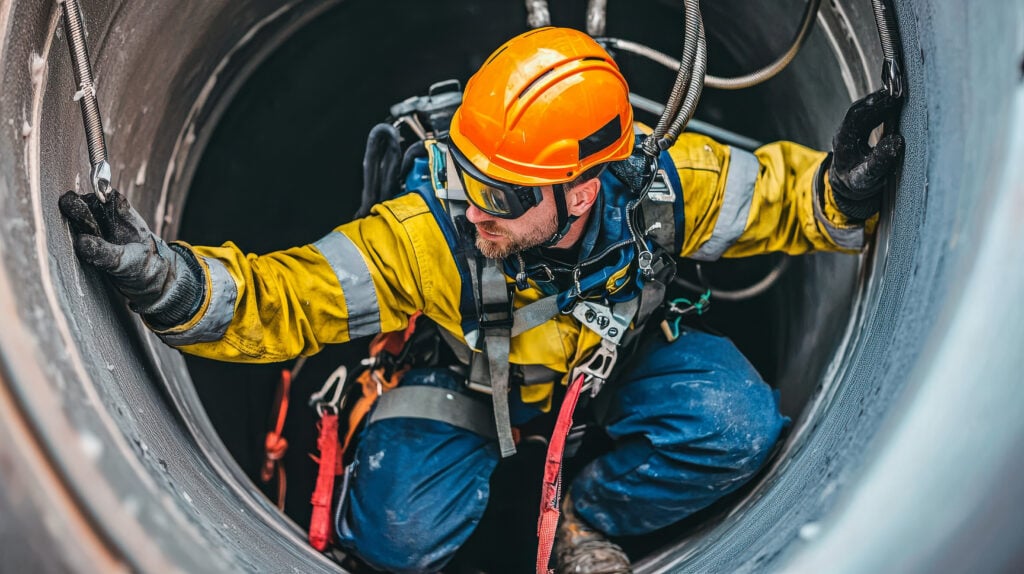Confined spaces look harmless until they fight dirty, let’s break down what you’re really walking into.
Confined spaces are some of the most hazardous environments in the workplace. These spaces are not designed for continuous occupancy and often present significant risks, including oxygen deficiency, toxic atmospheres, and entrapment hazards. Proper preparation, training, and adherence to OSHA standards are critical to ensure the safety of workers entering these environments. Here’s everything we’ll cover together:
- Understanding confined spaces and the hazards they present.
- Key roles and responsibilities of the entry team.
- Acceptable entry conditions and atmospheric monitoring.
- Emergency response and rescue protocols.
- Methods to ensure compliance with OSHA standards.
First things first, what even qualifies as a confined space and why is it trying to kill you?
A confined space, as defined by OSHA, has the following characteristics:
- It is large enough for an employee to enter and perform assigned work.
- It has limited or restricted means of entry and exit.
- It is not designed for continuous employee occupancy.
The primary hazards of confined spaces include:
- Atmospheric Hazards: Oxygen deficiency, flammable gases, and toxic vapors.
- Engulfment Hazards: Flowable substances, such as grain or sand, can trap or suffocate workers.
- Configuration Hazards: Narrow openings and irregular shapes can make escape difficult.
It takes a dream team to enter safely, here’s who does what on your confined space squad.
- Entry Supervisor:
- Ensures a safe entry plan is in place.
- Confirms all pre-entry measures, such as atmospheric testing, have been completed.
- Cancels the permit if hazardous conditions arise.
- Attendant:
- Stays outside the confined space and monitors the workers inside.
- Maintains communication with entrants at all times.
- Alerts the entry supervisor in case of emergencies or hazardous conditions.
- Entrants:
- Follow all safety protocols and wear required PPE.
- Continuously monitor conditions inside the space and communicate with the attendant.
- Exit the space immediately if unsafe conditions occur.
Before you dive in, the air better be clean and the rules better be tighter than your harness.
Atmospheric Testing Requirements:
- The air inside the confined space must be tested for:
- Oxygen Levels: Must remain between 19.5% and 23.5%.
- Flammable Gases and Vapors: Levels must remain below 10% of the lower explosive limit (LEL).
- Toxic Substances: Must not exceed permissible exposure limits (PELs) set by OSHA.
Your monitor better be working and your exit plan better be airtight.
Ventilation and Isolation Measures:
- Confined spaces should be ventilated to remove hazardous gases or supply fresh air.
- Energy sources (electrical, hydraulic, or pneumatic) must be locked out or tagged out to prevent accidental activation of machinery.
Personal Protective Equipment (PPE):
- Entrants must wear appropriate PPE, which may include respirators, chemical-resistant suits, gloves, and fall protection equipment.
Not all spaces are created equal, some need a permit just to survive inside.
Key elements of a confined space entry permit include:
- Identification of the confined space.
- The purpose of entry and expected duration.
- List of authorized personnel.
- Atmospheric testing results and acceptable entry conditions.
- Required PPE and equipment.
- Emergency and rescue procedures.
OSHA rules aren’t just paperwork, they’re lifesaving protocol in tight quarters.
Critical requirements include:
- Conducting a thorough hazard assessment for all confined spaces in the workplace.
- Establishing and maintaining a confined space entry program.
- Providing training for all personnel involved in confined space operations.
- Keeping records of permits, training sessions, and atmospheric testing results.
Employers must foster a culture of safety where workers feel empowered to speak up about potential hazards and follow established protocols.
Think tight spaces are scary? Try navigating one untrained and unprepared.
Key points to remember:
- Identify confined spaces in your workplace and assess their hazards.
- Ensure all team members understand their roles and responsibilities.
- Follow acceptable entry conditions, including atmospheric testing and ventilation.
- Use appropriate PPE and equipment to mitigate risks.
- Always have a rescue plan in place and ensure rescue teams are trained and equipped.
Your safety and the safety of your team depend on vigilance, preparation, and adherence to protocols.
Hot job site? Add another layer of protection with heat stress training.
Confined spaces are bad enough without the heat turning them into human ovens. Don’t forget to brush up on thermal safety too with our Heat Stress: Employee Safety Training Course. You’ll thank us later.
Expand your knowledge with advanced confined space training.
This training provided an overview of confined space safety, but advanced courses are available for those seeking deeper knowledge and hands-on experience. Consider enrolling in our Confined Space Entry and Rescue Training Course to further enhance your skills.
References



